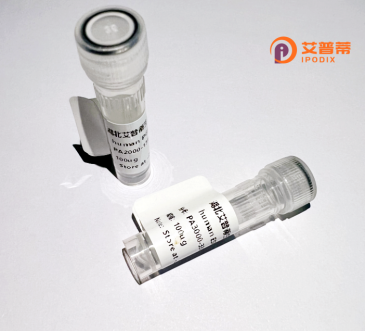
| 纯度 | >90%SDS-PAGE. |
| 种属 | Human |
| 靶点 | BHLHE22 |
| Uniprot No | Q8NFJ8 |
| 内毒素 | < 0.01EU/μg |
| 表达宿主 | E.coli |
| 表达区间 | 1-381aa |
| 氨基酸序列 | MERGMHLGAA AAGEDDLFLH KSLSASTSKR LEAAFRSTPP GMDLSLAPPP RERPASSSSS PLGCFEPADP EGAGLLLPPP GGGGGGSAGS GGGGGGGVGV PGLLVGSAGV GGDPSLSSLP AGAALCLKYG ESASRGSVAE SSGGEQSPDD DSDGRCELVL RAGVADPRAS PGAGGGGAKA AEGCSNAHLH GGASVPPGGL GGGGGGGSSS GSSGGGGGSG SGSGGSSSSS SSSSKKSKEQ KALRLNINAR ERRRMHDLND ALDELRAVIP YAHSPSVRKL SKIATLLLAK NYILMQAQAL EEMRRLVAYL NQGQAISAAS LPSSAAAAAA AAALHPALGA YEQAAGYPFS AGLPPAASCP EKCALFNSVS SSLCKQCTEK P |
| 分子量 | 68.31 kDa |
| 蛋白标签 | GST-tag at N-terminal |
| 缓冲液 | 冻干粉 |
| 稳定性 & 储存条件 | Lyophilized protein should be stored at ≤ -20°C, stable for one year after receipt. Reconstituted protein solution can be stored at 2-8°C for 2-7 days. Aliquots of reconstituted samples are stable at ≤ -20°C for 3 months. |
| 复溶 | Always centrifuge tubes before opening.Do not mix by vortex or pipetting. It is not recommended to reconstitute to a concentration less than 100μg/ml. Dissolve the lyophilized protein in distilled water. Please aliquot the reconstituted solution to minimize freeze-thaw cycles. |
1. **"BHLHE22 regulates neurogenic differentiation in the mouse cerebral cortex"** by Saito et al.
摘要:研究揭示了BHLHE22在小鼠大脑皮层神经前体细胞分化中的关键作用,通过调控细胞周期退出和神经元特异性基因表达,影响神经发生过程。
2. **"BHLHE22 suppresses colorectal cancer progression through transcriptional repression of oncogenic targets"** by Jiang et al.
摘要:发现BHLHE22在结直肠癌中作为肿瘤抑制因子,通过结合特定DNA序列抑制促癌基因(如MYC)的转录,其表达缺失与患者预后不良相关。
3. **"BHLHE22 modulates circadian rhythms through interaction with CLOCK/BMAL1 complexes"** by Ueda et al.
摘要:阐明BHLHE22作为昼夜节律调控网络的组成部分,通过与核心时钟蛋白相互作用抑制靶基因表达,影响生物钟的相位和振幅。
4. **"Epigenetic silencing of BHLHE22 promotes tumor aggressiveness in neuroblastoma"** by Nakakura et al.
摘要:研究证明BHLHE22在神经母细胞瘤中因启动子高甲基化而失活,其低表达与肿瘤分化程度低、转移风险升高相关,恢复表达可抑制细胞侵袭能力。
BHLHE22 (Basic Helix-Loop-Helix Family Member E22), also known as DEC1 or STRA13. is a transcription regulator belonging to the basic helix-loop-helix (bHLH) protein family. It functions as a transcriptional repressor by binding to E-box DNA motifs, modulating gene expression involved in cellular differentiation, proliferation, apoptosis, and circadian rhythm regulation. Initially identified for its role in neuronal and retinal development, BHLHE22 is crucial for maintaining photoreceptor function and regulating circadian processes in the retina. It also participates in diverse physiological pathways, including hypoxia response, metabolism, and immune regulation. Dysregulation of BHLHE22 has been linked to cancer progression, where it exhibits dual roles as both a tumor suppressor and promoter depending on context. Additionally, mutations in BHLHE22 are associated with retinal degenerative diseases like autosomal dominant retinitis pigmentosa. Its regulatory interplay with other bHLH proteins and epigenetic modifiers highlights its therapeutic potential, though mechanistic details remain under active investigation. Recent studies emphasize its context-dependent interactions in tissue homeostasis and disease, driving interest in its application as a biomarker or therapeutic target.
×